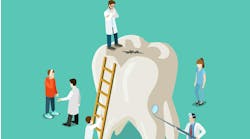Charles Settles
As the United States health-care system struggles to control costs, providers must find ways to increase value while reducing overhead. Lean practice management, in conjunction with the right medical software, helps practices achieve this without sacrificing patient care.
According to a December 2014 research brief from the ADA's Health Policy Institute, "the prospects for dentist earnings remain unclear."1 According to the brief's authors, there are a number of factors causing the uncertainty, but this much is clear: "average incomes have decreased significantly since the peak [...] in 2005." The downward pressure on dental incomes isn't likely to reverse. To ensure continued profitability, dentists must either increase revenue or cut costs.
Defining Lean Practice Management
"Lean" is a management methodology, born in Japanese auto manufacturing plants, that focuses on "creating more value for customers with fewer resources," as defined by the Lean Enterprise Institute.2 In other words, it is doing more with less. In an age of dwindling reimbursement and ever-increasing regulation, dentists are likely familiar, albeit not entirely comfortable, with such a concept.
Though it may seem odd to use a production methodology in a service business, lean principles have been used to manage numerous industries-including health care. Regardless of the application, reducing waste and increasing efficiency are the main focuses. At an auto manufacturer, this might entail inventory reduction for required parts via a "just-in-time" delivery model. While dental care and manufacturing automobiles have little in common, the lean method is applied to both in surprisingly similar ways.
The Lean Dental Practice
To begin implementing lean principles in your dental practice, map out your current processes. For an auto manufacturer, this would entail documenting each task performed at each stop the vehicle makes on the assembly line. At a dental practice, this means tracing the path of the patient from beginning to end. A visual representation, such as a flowchart, will help you map the process and discover bottlenecks, duplicative efforts, or other inefficiencies.
Once you've established your map, it's useful to take a walk in your patients' shoes. Call and schedule an appointment for yourself, and observe the way your practice functions from a patient's perspective. Ask your patients for their input as well. What are their frustrations with your current processes? What do they value most? This can be done through focus groups or patient surveys, but questioning them personally will allow you to clarify their needs and wants, ask follow-up questions, and show patients you value their opinions.
Now, armed with your chart and observations, take a critical look at your current workflow. Inefficiency can take many forms but, most frequently, will involve one of the following six areas:
• Overproduction-The completion of work for which there isn't a clear, current need
• Transit-Any unnecessary movement of patients, staff, dentists, or materials
• Waiting-Any delays involving patients, staff, or dentists waiting for resources, such as a patient waiting for the dentist to finish another exam
• Inventory-Any materials stocked for future use, such as cotton rolls, bonding agents, etc.
• Overprocessing-Excessive or inefficient work practices, such as scheduling two visits where a slightly longer single visit would have sufficed
• Rework-Any unnecessary work forced by an error, such as a crown being sent back to the lab because of improper fit
Once you've identified your problem areas, address them. Redraw your process with the changes necessary to reduce or eliminate inefficiency. A six-month study at a New York cerebral palsy center identified 12 principles to aid in lean practice management. The following six points are a condensed version:3
• Don't move the patient-Bring the work to the patient instead of the opposite.
• Eliminate needless work-"Because we've always done it this way" isn't a valid reason to continue something.
• Start/end appointments on schedule-As any dentist is aware, a five-minute delay starting the day can grow exponentially as the day progresses.
• Increase time with the patient-Not only is this likely to make your patients happier, it also allows you to be more effective, as you'll see or hear your patients' needs without interference or miscommunication.
• Broaden staff responsibilities-This allows your staff to complete necessary work with a minimal amount of hand-offs or other delays.
• Leverage technology-Automate, automate, automate.
Following this outline, the New York center saw patient throughput rise 58%, while the time patients spent in the office fell 40%.
Automation
Without automation, the auto industry today would likely not exist. Even with the increased efficiency delivered by lean methods, the cost to train, pay, and insure the large number of workers required to run an assembly line without automation would be cost-prohibitive. Thankfully, investing in automation for your practice is less capital-intensive. You're likely already using some form of practice management software, at least partially. Modern practice management systems offer efficiency-boosting tools, such as automated appointment reminders, online scheduling and patient registration, secure patient/provider messaging, and online bill pay. Even if your current system doesn't offer these features, there are a host of add-on products that, more than likely, directly integrate with your existing system(s). Using these tools correctly will allow you to repurpose or reduce the number of staff working each day. If your patients fill out their registration forms, confirm their appointments, and pay their bills online, how many front desk staffers are needed to perform the duties that remain-especially if you're using electronic dental records software that automatically fills and submits insurance claims?
Next Steps
Using these tactics, you can improve practice efficiency and reduce your overhead while streamlining the patient experience. Before getting started though, make sure you're familiar with the latest dental practice management and patient engagement software. You can find great resources at Dental Economics and DentistryIQ's practice management archives or TechnologyAdvice.com.
References
1. Munson M, Vujicic M. Dentist earnings not recovering with economic growth. Health Policy Institute Research Brief. American Dental Association. December 2014. http://www.ada.org/~/media/ADA/Science%20and%20Research/HPI/Files/HPIBrief_1214_1.ashx. Published December 2014. Accessed May 27, 2015.
2. What is Lean? http://www.lean.org/WhatsLean/. Accessed 26 May 2015.
3. Achieving a new standard in primary care for low-income populations: Case study I: Redesigning the patient visit. http://www.commonwealthfund.org/publications/fund-reports/2004/aug/achieving-a-new-standard-in-primary-care-for-low-income-populations--case-study-1--redesigning-the-p. Accessed June 1, 2015.
Charles "Drew" Settles is a product analyst at TechnologyAdvice, a technology marketing and research firm dedicated to educating, advising, and connecting buyers and sellers of business technology. In his work, Charles has extensively written and researched topics related to health-care IT, business intelligence, and other emerging technologies. Connect with him on LinkedIn.





